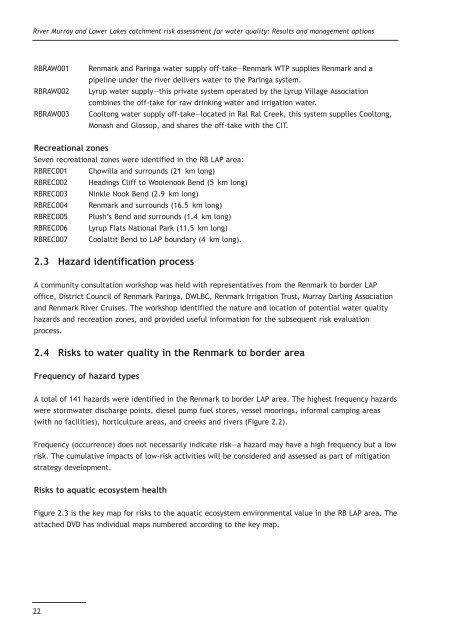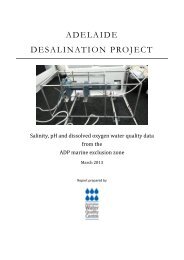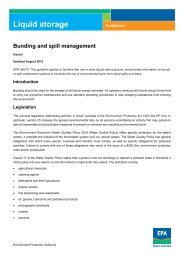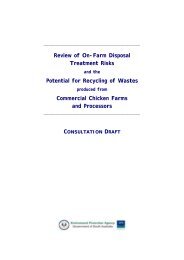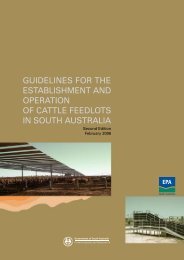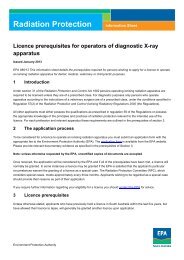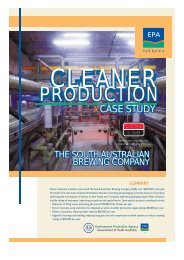2 Renmark to border LAP area assessment - EPA - Sa.gov.au
2 Renmark to border LAP area assessment - EPA - Sa.gov.au
2 Renmark to border LAP area assessment - EPA - Sa.gov.au
Create successful ePaper yourself
Turn your PDF publications into a flip-book with our unique Google optimized e-Paper software.
River Murray and Lower Lakes catchment risk <strong>assessment</strong> for water quality: Results and management options<br />
RBRAW001 <strong>Renmark</strong> and Paringa water supply off-take—<strong>Renmark</strong> WTP supplies <strong>Renmark</strong> and a<br />
pipeline under the river delivers water <strong>to</strong> the Paringa system.<br />
RBRAW002 Lyrup water supply—this private system operated by the Lyrup Village Association<br />
combines the off-take for raw drinking water and irrigation water.<br />
RBRAW003 Cool<strong>to</strong>ng water supply off-take—located in Ral Ral Creek, this system supplies Cool<strong>to</strong>ng,<br />
Monash and Glossop, and shares the off-take with the CIT.<br />
Recreational zones<br />
Seven recreational zones were identified in the RB <strong>LAP</strong> <strong>area</strong>:<br />
RBREC001 Chowilla and surrounds (21 km long)<br />
RBREC002 Headings Cliff <strong>to</strong> Woolenook Bend (5 km long)<br />
RBREC003 Ninkle Nook Bend (2.9 km long)<br />
RBREC004 <strong>Renmark</strong> and surrounds (16.5 km long)<br />
RBREC005 Plush’s Bend and surrounds (1.4 km long)<br />
RBREC006 Lyrup Flats National Park (11.5 km long)<br />
RBREC007 Coolaltit Bend <strong>to</strong> <strong>LAP</strong> boundary (4 km long).<br />
2.3 Hazard identification process<br />
A community consultation workshop was held with representatives from the <strong>Renmark</strong> <strong>to</strong> <strong>border</strong> <strong>LAP</strong><br />
office, District Council of <strong>Renmark</strong> Paringa, DWLBC, <strong>Renmark</strong> Irrigation Trust, Murray Darling Association<br />
and <strong>Renmark</strong> River Cruises. The workshop identified the nature and location of potential water quality<br />
hazards and recreation zones, and provided useful information for the subsequent risk evaluation<br />
process.<br />
2.4 Risks <strong>to</strong> water quality in the <strong>Renmark</strong> <strong>to</strong> <strong>border</strong> <strong>area</strong><br />
Frequency of hazard types<br />
A <strong>to</strong>tal of 141 hazards were identified in the <strong>Renmark</strong> <strong>to</strong> <strong>border</strong> <strong>LAP</strong> <strong>area</strong>. The highest frequency hazards<br />
were s<strong>to</strong>rmwater discharge points, diesel pump fuel s<strong>to</strong>res, vessel moorings, informal camping <strong>area</strong>s<br />
(with no facilities), horticulture <strong>area</strong>s, and creeks and rivers (Figure 2.2).<br />
Frequency (occurrence) does not necessarily indicate risk—a hazard may have a high frequency but a low<br />
risk. The cumulative impacts of low-risk activities will be considered and assessed as part of mitigation<br />
strategy development.<br />
Risks <strong>to</strong> aquatic ecosystem health<br />
Figure 2.3 is the key map for risks <strong>to</strong> the aquatic ecosystem environmental value in the RB <strong>LAP</strong> <strong>area</strong>. The<br />
attached DVD has individual maps numbered according <strong>to</strong> the key map.<br />
22


